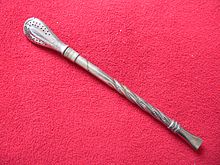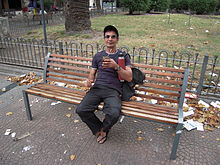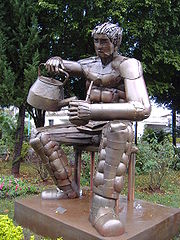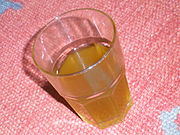- Mate (beverage)
-
For other uses, see Mate (disambiguation).
Mate 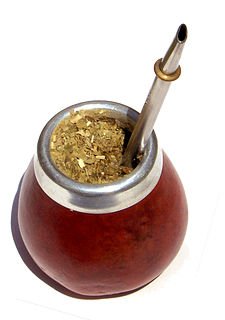
Mate in a traditional calabash gourd.Type Infusion Country of origin Paraguay, Uruguay, Argentina, Brazil Introduced 16th Century AD[1] Mate (Spanish pronunciation: [ˈmate]), also known as chimarrão (Portuguese: [ʃimaˈhɐ̃w̃]) or cimarrón, is a traditional South American infused drink, particularly in Argentina, Uruguay, Paraguay, southern states of Brazil, south of Chile, the Bolivian Chaco, and to some extent, Syria and Lebanon. It is prepared from steeping dried leaves of yerba maté (llex paraguariensis, known in Portuguese as erva mate) in hot water.
Mate is served with a metal straw from a shared hollow calabash gourd. The straw is called a bombilla in some Latin American countries, a bomba in Portuguese, and a bombija or in general a masassa (type of straw) in Arabic. The straw is traditionally made of silver. Modern, commercially available straws are typically made of nickel silver, called Alpaca, stainless steel, or hollow-stemmed cane. The gourd is known as a mate or a guampa, while in Brazil it has the specific name of cuia. Even if the water comes in a very modern thermos, the infusion is traditionally drunk from mates or cuias.
As with other brewed herbs, yerba mate leaves are dried, chopped, and ground into a powdery mixture called yerba. The bombilla acts as both a straw and a sieve. The submerged end is flared, with small holes or slots that allow the brewed liquid in, but block the chunky matter that makes up much of the mixture. A modern bombilla design uses a straight tube with holes, or spring sleeve to act as a sieve.[2]
"Tea-bag" type infusions of mate (mate cocido) have been on the market in Argentina, Paraguay and Uruguay for many years under such trade names as "Taragüí Vitality" in Argentina, "Pajarito" and "Kurupí" in Paraguay, and in Brazil under the name "Mate Leão". This is considered a completely different drink, and is never drunk on "cuias" or called "chimarrão", nor is it associated with the "gaúcha" culture.
Contents
Name
Both the spellings "mate" and "maté" are used in English.[3][4][5][6][7] The acute accent on the final letter is likely added as a hypercorrection, and serves to indicate that the word and its pronunciation are distinct from the common English word "mate". However, the Yerba Mate Association of the Americas states that it is always improper to accent the second syllable, since doing so confuses the word with an unrelated Spanish word for killing[8] ("Maté" literally means "I killed" in Spanish).
In Brazil, traditionally prepared mate is known as chimarrão, although the word mate and the expression "mate amargo" (bitter mate) are also used in Argentina and Uruguay. The Spanish cimarrón means "rough", "brute", or "barbarian", but is most widely understood to mean "feral", and is used in almost all of Latin America for domesticated animals that have become wild. The word was then used by the people who colonized the region of the Río de la Plata to describe the natives' rough and sour drink, drunk with no other ingredient to soften the taste.
Preparation
The method of preparing the mate infusion varies considerably from region to region, and which method yields the finest outcome is hotly debated. However, nearly all methods have some common elements. The beverage is traditionally prepared in the same gourd recipient, also called mate or guampa in Spanish and cuia in Portuguese, in which it is drunk. The gourd is nearly filled with yerba, and hot water (typically at 70–80 °C [160–180 °F], never boiling) is added.[9]
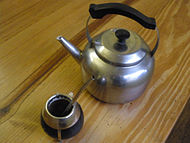
 A traditional calabash gourd with a kettle and a modern mate with an electric water boiler. Both pictures were taken in Buenos Aires, Argentina.
A traditional calabash gourd with a kettle and a modern mate with an electric water boiler. Both pictures were taken in Buenos Aires, Argentina.The most common preparation involves a careful arrangement of the yerba within the gourd before adding hot water. In this method, the gourd is first filled one-half to three-quarters of the way with yerba. Too much yerba will result in a "short" mate; conversely, too little yerba results in a "long" mate, both being considered undesirable. After that, any additional herbs ("yuyo", in Portuguese "jujo") may be added for either health or flavor benefits; a practice most common in Paraguay, where people acquire herbs from a local yuyera (herbalist) and use the mate as a base for their herbal infusions. When the gourd is adequately filled, the preparer typically grasps it with the full hand, covering and roughly sealing the opening with the palm. Then the mate is turned upside-down, and shaken vigorously, but briefly and with gradually decreasing force, in this inverted position. This causes the finest, most powdery particles of the yerba to settle toward the preparer's palm and the top of the mate.
Once the herb has settled, the mate is carefully brought to a near-sideways angle, with the opening tilted just slightly upward of the base. The mate is then shaken very gently with a side-to-side motion. This further settles the herb inside the gourd so that the finest particles move toward the opening and the yerba is layered along one side. The largest stems and other bits create a partition between the empty space on one side of the gourd and the lopsided pile of yerba on the other.
After arranging the yerba along one side of the gourd, the mate is carefully tilted back onto its base, minimizing further disturbances of the yerba as it is re-oriented to allow consumption. Some avalanche-like settling is normal, but is not desirable. The angled mound of yerba should remain, with its powdery peak still flat and mostly level with the top of the gourd. A layer of stems along its slope will slide downward and accumulate in the space opposite the yerba (though at least a portion should remain in place).
All of this careful settling of the yerba ensures that each sip contains as little particulate matter as possible, creating a smooth-running mate. The finest particles will then be as distant as possible from the filtering end of the straw. With each draw, the smaller particles would inevitably move toward the straw, but the larger particles and stems filter much of this out. A sloped arrangement provides consistent concentration and flavor with each filling of the mate.
Now the mate is ready to receive the straw. Many people choose to pour warm water into the mate before adding the straw, while others insist that the straw is best inserted into dry yerba. Wetting the yerba by gently pouring cool water into the empty space within the gourd until the water nearly reaches the top, and then allowing it to be absorbed into the yerba before adding the straw, allows the preparer to carefully shape and "pack" the yerba's slope with the straw's filtering end, which makes the overall form of the yerba within the gourd more resilient and solid. Dry yerba, on the other hand, allows a cleaner and easier insertion of the straw, though care must be taken so as not to overly disturb the arrangement of the yerba. Such a decision is entirely a personal or cultural preference. The straw is inserted with one's thumb on the upper end of the straw, at an angle roughly perpendicular to the slope of the yerba, so that its filtering end travels into the deepest part of the yerba and comes to rest near or against the opposite wall of the gourd. It is important that the thumb forms a seal over the end of the straw when it is being inserted, or the negative pressure produced will draw in undesirable particulates.
Brewing
Now the yerba may be brewed. If the straw was inserted into dry yerba, the mate must first be filled once with cool water as above, then be allowed to absorb it completely (which generally takes no more than two or three minutes). Treating the yerba with cool water before the addition of hot water is essential, as it protects the herb from being scalded and from the chemical breakdown of some of its desirable nutrients. Hot water may then be added by carefully pouring it, as with the cool water before, into the cavity opposite the yerba, until it reaches almost to the top of the gourd when the yerba is fully saturated. Care should be taken to maintain the dryness of the swollen top of the yerba beside the edge of the gourd's opening.
Once the hot water has been added, the mate is ready for drinking, and it may be refilled many times before becoming washed out (lavado) and losing its flavor. When this occurs, the mound of yerba can be pushed from one side of the gourd to the other, allowing water to be added along its opposite side; this revives the mate for additional re-fillings and is called "reformar o mate" (reforming the mate).
Etiquette
Mate drinking in typical Uruguayan way in public. Plaza Cagancha, Montevideo, Uruguay.
 Mate on the fly in Colonia del Sacramento.
Mate on the fly in Colonia del Sacramento.
Mate is traditionally drunk in a particular social setting, such as family gatherings or with friends. The same gourd (cuia) and straw (bomba/bombilla) are used by everyone drinking. One person (known in Portuguese as the preparador,[10] cevador or patrão, and in Spanish as the cebador) assumes the task of server. Typically, the cebador fills the gourd and drinks the mate completely to ensure that it is free of particulate matter and of good quality. In some places passing the first brew of mate to another drinker is considered bad manners, as it may be too cold or too strong; for this reason the first brew is often called mate del zonzo (mate of the fool). The cebador subsequently refills the gourd and passes it to the drinker to his or her right, who likewise drinks it all, without thanking the server. It is possible that the cebador drinks the second filling as well, if he or she deems it too cold or bitter. When there is no more tea, the straw makes a loud sucking noise, that is not considered rude. The ritual proceeds around the circle in this fashion until the mate becomes lavado ("washed out" or "flat"), typically after the gourd has been filled about ten times or more depending on the yerba used (well-aged yerba mate is typically more potent, and therefore provides a greater number of refills) and the ability of the cebador. When one has had his fill of mate, he or she politely thanks the cebador passing the mate back at the same time. When someone takes too long, others in the roda (Spanish: "ronda"; English: "round") will likely friendly warn him or her by saying "bring the talking gourd" (cuia de conversar); an Argentine equivalent, especially among young people, being "no es un micrófono" ("it's not a microphone"), an allusion to the drinker holding the mate for too long, as if they were using it as a microphone to deliver a lecture.
Some drinkers like to add sugar or honey, creating mate dulce (sweet mate), instead of sugarless mate amargo (bitter mate). It is considered bad for the gourd (especially for the natural (squash or wood) ones) to be used for mate dulce so it is normal for households with drinkers of both kinds to have two separate gourds. It is also often considered proper only for children and women, not for adult men, though this is becoming quickly obsolete.
Traditionally, natural gourds are used, though wood vessels, bamboo tubes and gourd-shaped mates, made of ceramic or metal (stainless steel or even silver) are also common. The gourd is traditionally made out of the porongo or cabaça fruit shell. Gourds are commonly decorated with silver, sporting decorative or heraldic designs with floral motifs.
History
Mate was first consumed by the indigenous Guaraní and also spread by the Tupí people that lived in Southern Brazil. The consumption of mate became widespread with the European colonization. The consumption of yerba mate became widespread in the Spanish colony of Paraguay in the late 16th century both among Spanish settlers and indigenous Guaraní, who consumed it before the Spanish arrival. Mate consumption spread in the 17th century to the River Plate and from there to Chile, Bolivia and Peru. This widespread consumption turned it into Paraguay's main commodity above other wares like tobacco, cotton, and beef. Aboriginal labour was used to harvest wild stands. In the mid 17th century Jesuits managed to domesticate the plant and establish plantations in their Indian reductions in the Paraguayan department of Misiones, sparking severe competition with the Paraguayan harvesters of wild strands. After their expulsion in the 1770s, the Jesuit missions - along with the yerba mate plantations - fell into ruins. The industry continued to be of prime importance for the Paraguayan economy after independence, but development in benefit of the Paraguayan state halted after the War of the Triple Alliance (1864–1870) that devastated the country both economically and demographically.
Brazil then became the largest producer of mate. In Brazilian and Argentine projects in late 19th and early 20th century the plant was domesticated once again, opening the way for plantation systems. When Brazilian entrepreneurs turned their attention into coffee in the 1930s, Argentina, which had long been the prime consumer, took over as the largest producer, resurrecting the economy of Misiones Province, where the Jesuits had once had most of their plantations. For years the status of largest producer shift between Brazil and Argentina.[11]
Litograph of José Gaspar Rodríguez de Francia, a 19th century ruler of Paraguay, with a mate and its respective bombilla. Main article: History of yerba mate
Main article: History of yerba mateNowadays, Brazil is the largest producer with 53%, followed by Argentina, 37% and Paraguay, 10%.[12]
There is a Parque Historico do Mate, funded by the State of Parana, Brazil, to educate all of the people on the sustainable harvesting methods needed to maintain the integrity and vitality of the oldest wild forests of mate in the world: http://www.museuparanaense.pr.gov.br/modules/conteudo/conteudo.php?conteudo=56 [13]
Culture
Mate is the national drink of Argentina[14], Paraguay, where it is also consumed with either hot or ice cold water (see tereré)[15], and Uruguay. Drinking mate is a common social practice in parts of Brazil, Chile, eastern Bolivia. Throughout the Southern Cone, it is considered to be a tradition typical of the Gauchos or vaqueros, terms commonly used to describe residents of the South American pampas, chacos, or Patagonian grasslands, found principally in parts of Argentina, Paraguay, Uruguay, Southern Chile, and southern Brazil.
Rituals
Drinking the yerba mate is considered to be more than just good for the body; it's also considered to be good for the soul. Drinking it can be a form of meditation or reflection - allowing the goodness to infuse into the body while stimulating and resting the mind. Those who share the mate join in a kind of bond of total acceptance and friendship. Generally the server will start a new infusion and then take the first drink. This is considered an act of kindness by the other people in the circle, because usually the first serving is considered the worst.
Both the wood vessels and the gourds must undergo curing to get a better taste before being used for the first time and to ensure the long life of the gourd. Typically, to cure a gourd, the wet inside is first scraped with the tip of a teaspoon to remove loose gourd particles. Mate herb and hot water is added next, and the mixture poured into the gourd. The mixture is left to sit overnight and the water is topped off periodically through the next 24 hours as the gourd absorbs the water. Finally the gourd is scraped out, emptied, and put in sunlight until completely dry. Drying the gourd near a Parrilla (barbecue grill) is common in Argentina or Uruguay and adds a smokey flavor to the gourd.
It is common for a black mold to grow inside a poorly scraped gourd when it is stored wet. Some people will clean this out, others consider it an enhancement to the mate flavor.[citation needed]
Health effects
Like other caffeine-rich infusion, such as coffee and tea, mate is generally recognized as safe by the United States Food and Drug Administration.
Mate tea contains several vitamins and minerals important to human health, including vitamins A (as beta-carotene), B1, B2, C and E, as well as phosphorus, iron and calcium.[9][16]
Antioxidants and anticarcinogens
Yerba mate tea contains significant levels of polyphenol antioxidants, and has a slightly higher antioxidant capacity than green tea. On average, mate tea contains 92 milligrams of the antioxidant chlorogenic acid per gram of dry leaves, and no catechins,[16] giving it a significantly different antioxidant profile than other teas.[17]
In-vivo and in-vitro studies are showing that yerba mate exhibits significant cancer-fighting activity. In 1995, research at the University of Illinois found yerba mate to inhibit the proliferation of oral cancer cells.
Correlations with incidence of cancer
Researchers in Mississippi found that both cold and hot water extractions of popular commercial yerba mate products contained high levels (8.03 to 53.3 ng/g dry leaves) of carcinogenic polycyclic aromatic hydrocarbons (PAHs) (i.e. Benzo[a]pyrene).[18] However, these potential carcinogenic compounds originate from commercial drying process of the mate leaves, which involves smoke from the burning of wood, much like polycyclic aromatic hydrocarbons found in wood smoked meat.[19] "Un-smoked" or steamed varieties of yerba mate tea are available[20] which may reduce this risk, though research comparing relative cancer risks of smoked versus steamed yerba mate is not available. One study found that the antioxidant properties of mate tea remain the same between both smoked and un-smoked varieties.[21]
Other studies have highlighted limited evidence showing an association between esophageal cancer and hot mate drinking. Some research has suggested that this effect is almost entirely a consequence of hot mate's temperature; similar links to cancer have been found for tea and other beverages generally consumed at high temperatures. While drinking mate at very hot temperatures is considered as "probably carcinogenic to humans" on the IARC Group 2A carcinogens list, mate itself is not classifiable as to its carcinogenicity to humans.[22]
One study found a link between mate consumption and increased risk of bladder[23] cancer, although the increased risk was relatively similar to the risks associated with the consumption of other common caffeinated beverages such as coffee and tea.
One study found an increased risk for lung[24] cancer. Another study associated mate drinking with the development of non-Hodgkin lymphoma.[25]
Effect on cholesterol levels
A 2007 study from the University of Illinois conducted by Elvira de Mejia Ph.D, (Plant Biotechnology) [26] found that consuming 0.5 liters of yerba mate tea increases activity levels of the enzyme that produces HDL cholesterol, and lowers levels of LDL cholesterol. Study participants drinking mate tea had a 10% increase in the level of cardioprotective enzyme PON1, a precursor to HDL, compared to others drinking milk or coffee.[27]
An in vivo study conducted by the University of São Francisco and the University of São Paulo in Brazil in 2009 found that mice fed high-fat diets for 12 weeks had significant improvements in blood serum levels of cholesterol, triglycerides, LDL cholesterol, and glucose after being orally administered a solution of purified water and instant yerba mate tea powder.[28]
Legendary origins
The Guaraní (Guarani, in Portuguese) people started drinking mate in the region that now includes Paraguay, southern Brazil, south-eastern Bolivia, north-east Argentina, and Uruguay. The Guaraní have a legend that says that the Goddesses of the Moon and the Cloud came to the Earth one day to visit it but they instead found a Yaguareté (a jaguar) that was going to attack them. An old man saved them, and, in compensation, the Goddesses gave the old man a new kind of plant, from which he could prepare a "drink of friendship".
Variants
There is another drink that can be prepared with specially cut dry leaves, very cold water and, optionally, lemon or another fruit juice, called tereré. It is very common in Paraguay, northeastern Argentina and in the state of Mato Grosso do Sul, Brazil. After pouring the water, it is considered proper to "wait while the saint has a sip" before the first person takes a drink. In Southern Brazil, tererê is sometimes used as a derogatory term for a not hot enough chimarrão.
In Uruguay and Brazil the traditional gourd is usually big with a corresponding large hole. In Argentina (especially in the capital, Buenos Aires) the gourd is small and has a small hole, and people sometimes add sugar for flavor.
In Uruguay it is common to see people walking around the streets toting a mate and a thermos with hot water. In some parts of Argentina, gas stations sponsored by yerba mate producers provide free hot water to travelers, specifically for the purpose of drinking during the journey. There are disposable mate sets with a plastic mate and straw, and sets with a thermos flask and stacking containers for the yerba and sugar inside a fitted case. There is a national law In Uruguay that prohibits drinking mate while driving, because it caused many accidents of people getting scalded with hot water while driving.
In Argentina, mate cocido (boiled mate) is made with a teabag or leaves and drunk from a cup or mug, with or without sugar and milk. Companies such as Mar del Plata and Establecimiento Las Marías produce teabags for export to Europe.[29]
Most urban Chileans do not drink mate, but travel narratives such as Maria Graham's Journal of a Residence in Chile, show that there is a long history of mate drinking in central Chile. Many rural Chileans drink mate, in particular in the southern regions, particularly Chiloé and Magallanes, perhaps due to the influence of neighboring areas of Argentina.
In some provinces of the Middle Eastern countries of Syria and Lebanon it is also common to drink mate. There, the custom of drinking mate came from Arabs who moved to South America during the early twentieth century, adopted the habit, and kept it after returning home. Syria is the biggest importer of yerba mate in the world, importing 15,000 tons a year. It is mostly the Druze and Alawite communities in Syria and Lebanon who maintain the culture and practice of mate.[30][31]
According to a major retailer of mate in San Luis Obispo, California, by 2004 mate had grown to about 5% of the overall natural tea market in North America.[32][33] Loose Mate is commercially available in much of North America. Bottled mate is increasingly available in the United States. Canadian bottlers have introduced a cane sugar-sweetened carbonated variety, remarkably similar to soda-pop, less the fructose, chemically extracted caffeine and preservatives. One brand, Sol Mate, produces 10-ounce glass bottles available at Canadian and U.S. retailers, making use of this clever pun for the sake of marketing.[34]
Exports from Argentina
Of the 310,000 tons produced, 40,000 tons are exported, both in bulk and packed. With a 45% market share, Establecimiento Las Marias is the leader of the packed (branded) segment, which is 7,000 tons. Las Marias has taken the strategic decision to only sell branded products, either domestically or for export. Other companies exporting packed mate are Don Basilio and La Chacchuera. Many companies export bulk mate primarily, to Chile, Paraguay and Uruguay but also to Syria and Lebanon. North America, Europe and parts of Asia are growing markets for both forms of exports. Bulk mate is used both as the raw material for brands and as an ingredient in other products, such as energy drinks. The Middle East, accounting for roughly 60% of exports, is such a major market because there was a reverse migration in the 1950’s. Those who retuned had been in Argentina for several generations and had therefore picked up the local habits, such as drinking mate in the traditional way. New markets are being developed in Europe and in North America. Most of the new markets are teabag ones, but Poland is an exception. There, traditional mate is a seen as quick and easy adventurous experience, perhaps similar to smoking a hookah, which also has an inherent social component.
See also
- Black drink
- Club-Mate
- List of Brazilian dishes
- Mate de coca
- Materva (Trademark of a Yerba Mate soft drink)
- Huarisnaque
References
- ^ "El té de los Jesuitas (historia de la yerba mate)". Miguel Krebs. http://www.historiacocina.com/historia/articulos/mate.htm. Retrieved 2010-12-14.
- ^ Goodfriend, Anne (2006-03-02). "Yerba maté: The accent is on popular health drink". USA Today. pp. 1. http://www.usatoday.com/travel/destinations/2006-03-02-yerba-mate_x.htm. Retrieved 2011-05-29.
- ^ Webster's Third New International Dictionary of the English Language Unabridged, 2002, shows the main entry for the word as ma·té or ma·te. The explanatory material for main entries on page 14a, headed 1.71, says "When a main entry is followed by the word or and another spelling or form, the two spellings or forms are equal variants. Their order is usually alphabetical, and the first is no more to be preferred than the second..."
- ^ The New Oxford American Dictionary
- ^ The Oxford English Dictionary
- ^ American Heritage Dictionary of the English Language
- ^ Merriam-Webster's Online Dictionary
- ^ "FAQs: Pronunciation and Spelling". Yerba Mate Association of the Americas. http://www.yerbamateassociation.org/index.php?p=faq#101. Retrieved 2008-11-27.
- ^ a b Brooke, Elizabeth (1991-04-24). "Yerba Mate, Ancient Antidote To South America's Heat". The New York Times. p. 2. http://www.nytimes.com/1991/04/24/garden/yerba-mate-ancient-antidote-to-south-america-s-heat.html. Retrieved 2011-05-28.
- ^ chennifer (2011-05-21). "How to "Tomar Mate"". http://chennifer.wordpress.com/2011/03/15/how-to-tomar-mate-the-newbies-guide/. Retrieved 2011-05-29.
- ^ "History of Mate". Establecimiento Las Marías. http://comex.lasmarias.com.ar/eng/detalle.php?a=yerba-mate-tea&t=3&d=1. Retrieved 8 November 2011.
- ^ "FAOSTAT". http://faostat.fao.org/site/339/default.aspx. http://faostat.fao.org/site/339/default.aspx. Retrieved 2011-07-18.
- ^ "Nativa Yerba Mate". http://www.nativayerbamate.com/harvest.html. http://www.nativayerbamate/harvest.html. Retrieved 2011-07-18.
- ^ Sanders, Kerry. "Next time you're in Argentina, try a cup of mate". msnbc.com. pp. 1. http://today.msnbc.msn.com/id/24315283/ns/today-where_in_the_world/t/next-time-youre-argentina-try-cup-mate/. Retrieved 2011-05-29.
- ^ Conran, Caroline, Conran, Terence, and Hopkinson, Simon (2001). The Conran Cookbook. Conran-Octopus. ISBN 1840911824.
- ^ a b Yerba Mate Tea: A Comprehensive Review on Chemistry, Health Implications, and Technological Considerations. Journal of Food Science. 2007-10-17. pp. 1. doi:10.1111/j.1750-3841.2007.00535.x.
- ^ Polyphenols in green tea, black tea, and Mate tea. Journal of Food Science. 2007-10-17. doi:10.1111/j.1750-3841.2007.00535.x.
- ^ http://cebp.aacrjournals.org/cgi/content/abstract/17/5/1262
- ^ http://www.matteleao.com/produtos/arquivos/Yerba%20mate%20Pharmacological%20Properties%20Research%20and%20Biotechnology.pdf
- ^ http://yerbamate.com/drying-methods/
- ^ Both green mate and mate tea infusions showed comparable antioxidant activities, which indicates that the roasting stage, although it modifies both the profile of volatile compounds and the phenolic content of the infusion, does not affect the antioxidant property, as measured by the ferric thiocyanate method. 22 March 2005 Deborah H. Markowicz Bastos, Emilia Y. Ishimoto, Marcia Ortiz M. Marques, Adalberto Fernando Ferri, Elizabeth A.F.S. Torres Essential oil and antioxidant activity of green mate and mate tea (Ilex paraguariensis) infusions http://www.matteleao.com.br/pdf/Essential_Oil.pdf
- ^ "Mate (IARC Summary & Evaluation)". International Agency for Research on Cancer. 1991. p. 273. http://www.inchem.org/documents/iarc/vol51/03-mate.html.
- ^ There exists the possibility that mate could contain chemicals with carcinogenic activity. Thus, it remains the strong possibility that mate drinking could be carcinogenic to cancer sites not related with a direct contact with the beverage. In other words, our findings of a strong direct association between mate drinking and bladder cancer risk are partially supported by previous chemical, experimental and epidemiological studies in cancer of the bladder and of other organs. The present study replicates previous findings from Uruguay suggesting a role of mate in bladder carcinogenesis. Also, the effect of mate drinking among never smokers suggest that this beverage is an independent factor. 29 March 2007 Eduardo De Stefani, Paolo Boffetta, Hugo Deneo-Pellegrini, Pelayo Correa, Alvaro L Ronco, Paul Brennan, Gilles Ferro, Giselle Acosta and María Mendilaharsu Non-alcoholic beverages and risk of bladder cancer in Uruguay http://www.biomedcentral.com/content/pdf/1471-2407-7-57.pdf
- ^ The present study is, to our knowledge, the first one to consider the relationship between mate drinking and lung cancer risk. The results suggests that there is an effect of mate, independent of tobacco use, that is best shown by the daily amount of the beverage consumed. Moreover, the effect appears to be more evident in squamous cell and small cell cancers (Kreyberg I group). Lung cancer was considered a good model for testing a chemical rather than thermal effect of mate. Vol. 5. 515—519, July 1996 Cancer Epidemiology, Biomarkers & Prevention Eduardo De Stefani,2 Luis Fierro, Pelayo Correa, Elizabeth Fontham, Alvaro Ronco, Maria Larrinaga, Julio Balbi, and Maria Mendilaharsu Mate Drinking and Risk of Lung Cancer in Males: A Case-Control Study from Uruguay http://cebp.aacrjournals.org/cgi/reprint/5/7/515.pdf
- ^ http://www.lrjournal.com/article/S0145-2126%2897%2900194-X/abstract
- ^ "Elvira de Mejia Associate Professor". University of Illinois. pp. 1. http://fshn.illinois.edu/people/elvira_de_mejia. Retrieved 2011-05-28.
- ^ "Mate Tea Lowers Cholesterol". Medical News Today. 2007/24/10. pp. 2. http://www.medicalnewstoday.com/releases/86514.php. Retrieved 2011-05-28.
- ^ "Antiobesity Effects of yerba maté Extract (Ilex paraguariensis) in High-fat Diet–induced Obese Mice". Nature.com. 2009-05-14. pp. 1. http://www.nature.com/oby/journal/v17/n12/full/oby2009158a.html. Retrieved 2011-05-28.
- ^ Cabrales abrirá locales en la Capital La Nación online, 6 October 2001 (Spanish)
- ^ Luxner, Larry (Nov-Dec 1995). "Yerba Mate: The South American Leaf". Saudi Aramco World. http://www.luxner.com/cgi-bin/view_article.cgi?articleID=268. Retrieved 2009-01-25.
- ^ "Yerba Mate: What? Where? How? When?". ushuaia.pl. http://www.ushuaia.pl/yerba/where. Retrieved 2009-01-25.
- ^ "Guayaki Honored With 2004 Socially Responsible Business Award" (Press release). Guayaki. 2004-10-28. http://www.csrwire.com/News/3184.html.
- ^ Everage, Laura (2004-11-01). "Trends in Tea". The Gourmet Retailer. http://www.gourmetretailer.com/gourmetretailer/magazine/article_display.jsp?vnu_content_id=1000696346.
- ^ Rude, Justin (2007-01-19). "Tip Sheet: Lowdown on Liquid Power-Ups". Washington Post. http://www.washingtonpost.com/wp-dyn/content/graphic/2007/01/19/GR2007011900577.html. Retrieved 2011-05-29.
External links
- Instructions on how to prepare Mate with pictures
- Mate - sharing is a tradition
- Article about Mate with a video tutorial
Tea Black tea Oolong tea - Bai Ji Guan
- Red Robe
- Darjeeling Oolong
- Dongding (Tung-ting)
- Dong Fang Mei Ren
- Huangjin Gui (Golden Osmanthus)
- Qilan tea
- Pouchong
- Rou Gui
- Shui Jin Gui
- Shui Hsien (Shui Xian)
- Tie Luohan
- Tieguanyin (Iron Goddess)
Green tea - Aracha
- Bancha
- Green Spiral
- Chun Mee
- Da Fang
- Genmaicha
- Liuan Leaf
- Gunpowder
- Gyokuro
- Hojicha
- Hou Kui
- Huang Shan Mao Feng
- Hyson
- Kabusecha
- Kamairicha
- Konacha
- Kukicha
- Longjing (Dragon Well)
- Matcha
- Mao Jian
- Mecha
- Meng Ding Gan Lu
- Sencha
- Shincha
- Tamaryokucha
White tea Yellow tea Post-fermented tea Blended and
flavoured teasTea culture Tea beverages Other - Camellia sinensis (tea plant)
- Tea bag
- Teapot
- Consumption
- Flowering tea
- Glass-holder
- Health effects
- Tea processing
- Samovar
- Tea brick
- Tea garden
- Tea house
- Tea tasting
- Teakettle
See also Categories:- Herbal and fungal stimulants
- Herbal tea
- Latin American cuisine
- Syrian cuisine
- Tea culture
- Argentine cuisine
- Argentine culture
- Brazilian cuisine
- Brazilian culture
- Uruguayan cuisine
- Uruguayan culture
- Chilean culture
- Chilean cuisine
- Argentine beverages
- Brazilian beverages
- Chilean beverages
- Uruguayan beverages
- IARC Group 2A carcinogens
- Yerba mate
Wikimedia Foundation. 2010.

